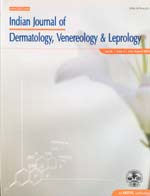
|
Indian Journal of Dermatology, Venereology and Leprology
Medknow Publications on behalf of The Indian Association of Dermatologists, Venereologists and Leprologists (IADVL)
ISSN: 0378-6323
EISSN: 0378-6323
Vol. 74, No. 1, 2008, pp. 80-80
|
 Bioline Code: dv08030
Bioline Code: dv08030
Full paper language: English
Document type: Study
Document available free of charge
|
|
|
Indian Journal of Dermatology, Venereology and Leprology, Vol. 74, No. 1, 2008, pp. 80-80
| en |
A study of oxidative stress in paucibacillary and multibacillary leprosy
Jyothi, P.; Riyaz, Najeeba; Nandakumar, G. & Binitha, M.P.
Abstract
Background: The study and assessment of oxidative stress plays a significant role in the arena of leprosy treatment. Once the presence of oxidative stress is proved, antioxidant supplements can be provided to reduce tissue injury and deformity.
Aim: To study oxidative stress in paucibacillary (PB) and multibacillary (MB) leprosy and to compare it with that in a control group.
Methods: Fifty-eight untreated leprosy patients (23 PB and 35 MB cases) were studied and compared with 58 healthy controls. Superoxide dismutase (SOD) level as a measure of antioxidant status; malondialdehyde (MDA) level, an indicator of lipid peroxidation; and MDA/SOD ratio, an index of oxidative stress were estimated in the serum.
Results: The SOD level was decreased in leprosy patients, especially in MB leprosy. The MDA level was increased in PB and MB leprosy. The MDA/SOD ratio was significantly elevated in MB patients. There was a steady increase in this ratio along the spectrum from tuberculoid to lepromatous leprosy (LL).
Conclusion: There is increased oxidative stress in MB leprosy, especially in LL. This warrants antioxidant supplements to prevent tissue injury.
Keywords
Leprosy, malondialdehyde, oxidative stress, superoxide dismutase
|
| |
© Copyright 2008 Indian Journal of Dermatology, Venereology and Leprology.
Alternative site location: http://www.ijdvl.com
|
|
